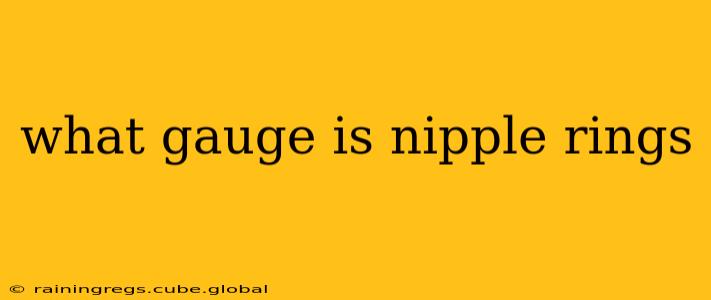What Gauge is Nipple Rings?
Choosing the right gauge for your nipple rings is crucial for comfort, safety, and the overall aesthetic look. Unlike other piercings, nipple piercings often require a slightly thicker gauge to accommodate the delicate anatomy of the nipple and prevent migration or rejection. Let's delve into the details.
What Gauge Sizes are Commonly Used for Nipple Piercings?
The most common gauge for nipple piercings is 14 gauge (1.6mm). This size provides a good balance between strength and comfort. It's thick enough to support the jewelry and withstand daily wear and tear, yet thin enough to minimize discomfort and potential irritation. You might also see 12 gauge (2.0mm), but this is less common initially as it's thicker and might be more challenging for initial piercing.
Some people may opt for smaller gauges such as 16 gauge (1.2mm), but these are less common for initial piercings due to the increased risk of rejection. The thinner gauge may not provide sufficient support for the jewelry and increase the risk of the piercing closing prematurely.
Are Larger Gauges Used for Nipple Piercings?
While less common for initial piercings, larger gauges, such as 10 gauge (2.5mm) or even larger, can be used. These are generally chosen after the piercing has fully healed, typically by individuals who want to stretch their piercings. This process should be done gradually and carefully under the guidance of a reputable piercer to minimize damage or scarring.
What Factors Influence Nipple Ring Gauge Selection?
Several factors influence the choice of gauge for nipple piercings:
- Individual Anatomy: The size and shape of the nipple influence the appropriate gauge. A larger nipple may accommodate a slightly larger gauge, while a smaller nipple might require a smaller one.
- Piercer's Recommendation: Your piercer's expertise is invaluable. They'll assess your anatomy and advise on the most suitable gauge for a successful piercing. Always consult a professional piercer before getting a piercing.
- Healing Process: The gauge plays a role in the healing process. A properly sized gauge minimizes trauma and reduces the chances of infection or complications.
- Jewelry Preference: The availability of jewelry also influences gauge choices. Certain designs are only available in particular gauges.
What Happens If I Choose the Wrong Gauge?
Choosing an improper gauge can lead to several issues:
- Rejection: A gauge that is too small might cause the body to reject the piercing, leading to its expulsion.
- Migration: The piercing might migrate out of its intended place.
- Increased risk of infection: A poorly sized piercing increases susceptibility to infection.
- Discomfort and irritation: An incorrectly sized piercing is likely to cause discomfort and irritation.
How to Care for Your Nipple Piercing?
Proper aftercare is essential to ensure your piercing heals correctly. This typically involves regular cleaning with saline solution or a mild antiseptic solution and avoiding touching the piercing unnecessarily. Your piercer will give you detailed aftercare instructions tailored to your specific situation.
Remember: Always consult with a reputable and experienced piercer for any questions regarding nipple piercings. They can provide professional guidance on gauge selection and aftercare, ensuring a successful and safe piercing experience. Do not attempt to self-pierce nipples; this can lead to serious complications.
